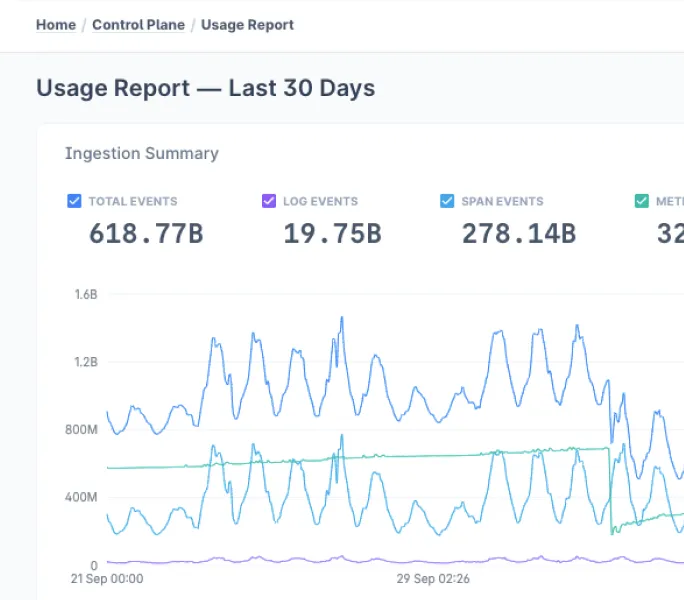OpenTelemetry and OpenTracing are both open-source projects in the observability space, but they serve different purposes and have distinct features.
OpenTelemetry provides a complete toolkit for monitoring that includes metrics, logs, and traces, while OpenTracing is solely focused on distributed tracing. This article explores the key differences between these two technologies and helps you understand which might be more suitable for your needs.
Quick Comparison
| Feature | OpenTelemetry | OpenTracing |
|---|---|---|
| Scope | Metrics, logs, and traces | Primarily tracing |
| Vendor Support | Wide vendor support | Limited vendor support |
| API | Unified API | Separate APIs for different telemetry types |
| Future Development | Active development | Deprecated in favor of OpenTelemetry |
| Community | Large, growing community | Smaller, stable community |
| Instrumentation | Auto and manual instrumentation | Manual instrumentation |
What is OpenTelemetry?
OpenTelemetry is an observability framework for cloud-native software that provides a collection of tools, APIs, and SDKs for generating, collecting, and exporting telemetry data.
It aims to standardize the way telemetry data is collected and transmitted, making it easier for organizations to implement robust observability practices.
It unifies the capabilities of OpenTracing and OpenCensus projects into a comprehensive framework with logging, distributed tracing, and metrics collection features.
What is OpenTracing?
OpenTracing is an open-source standard for distributed tracing, providing vendor-neutral APIs for instrumenting, propagating, and collecting trace data. It was one of the first attempts to standardize distributed tracing across different platforms and languages.
OpenTracing solved this problem via its unified instrumentation API, compatible with several programming languages—such as Java, Python, Go, PHP, C#, and JavaScript—and multiple tracing systems and backends.
OpenTracing provides a set of primitives for creating and manipulating traces and spans. A trace represents the journey of a single request, while spans represent individual work units within that trace. Spans are linked to visualize the complete path and relationships between different components with a trace ID.
Features of OpenTelemetry
OTel offers several critical features for instrumenting applications and collecting telemetry data.
Three Pillars of Observability
Observability has three pillars: Metrics, Logs, and Traces.
The table below gives an overview of how OTel eases the collection and aggregation of each pillar.
| Observability Pillar | Overview |
|---|---|
| Logs | OTel's structured logging enables you to connect log entries with contextual information, including request and user IDs, and timestamps. It integrates with libraries and logging frameworks so that its Collector can read logs from multiple sources, including third-party logging systems. |
| Metrics | It is no news that OTel eases metrics collection. However, aside from collection, what else can you do? OTel enables you to correlate the metrics with traces and logs: for example, metrics-to-traces correlation via exemplars. It also enables the delivery of pre-aggregated metrics by providing protocol specifications and semantic conventions that ensure metric data is standardized across collection paths and observability platforms. |
| Traces | OTel provides end-to-end visibility into requests flowing through multiple services in the application. Visualizing how requests interact with each service eases the identification of suboptimal/malfunctioning components. |
Vendor Neutral
An essential feature of OTel is that its OpenTelemetry Collector integrates with and can send different metrics to popular observability solutions, allowing you to choose your preferred telemetry backends and avoid vendor lock-in.
Compatibility with OpenTracing and OpenCensus
OpenTelemetry combines and enhances the features of OpenTracing and OpenCensus, offering a unified framework for collecting metrics, traces, logs, and metadata.
It also provides a bridging API for compatibility, allowing developers to seamlessly migrate from OpenTracing or OpenCensus to OpenTelemetry.
Extensibility
OTel defines APIs as allowing extension points to incorporate other components and technologies and a flexible architecture that allows for compatibility.
This enables the addition of custom instrumentation, exporters, and telemetry backend, ensuring that OTel can be adapted to fit different application requirements and environments.
Features of OpenTracing
OpenTracing offers the following essential features.
Highly consistent and functional API
OpenTracing has two API categories: Tracers and Spans.
Tracers are highly interoperable and are used to create, insert, and extract span contexts. They can be initiated to automate span creation. After span creation, tag aggregation and the addition of baggage items follow.
Tracing Instrumentation
As a transaction—such as query transmission to the server—progresses, one or more spans are created to encapsulate single work units in the lifecycle of a request. The spans can be stopped so you can annotate them using metadata.
Distributed Context Propagation
OpenTracing allows for the correlation of performance data across multiple systems to be reassembled into coherent traces (of individual request lifecycles), which enable end-to-end visibility.
Context propagation links span together to create a complete picture of request execution, providing insights into system behavior as the request journeys through the path.
Span Nesting
Nested spans provide a granular view of the execution path within individual services and components.
OpenTracing allows you to attach baggage items that facilitate cross-span propagation, easing the establishment of relationships between spans. This allows you to represent parent-child and follows-from relationships between spans.
Limitations of OpenTracing
While OpenTracing provides a solid foundation for distributed tracing, it does come with some limitations, especially in modern software environments.
Here are some key challenges:
- Fragmented Ecosystem: OpenTracing relies on third-party libraries and instrumentation to collect tracing data. This can lead to an inconsistent experience across different systems and services.
- Lack of Standardization: OpenTracing standards vary between implementations, which can create compatibility issues when integrating with other observability tools.
- Limited Scope: OpenTracing focuses primarily on tracing and does not natively handle metrics or logs, which limits its effectiveness in comprehensive observability. Users often need to rely on additional tools like OpenTelemetry for full-stack observability.
- Complexity in Setup: The setup and maintenance of OpenTracing can be complex, especially in large, microservices-based environments. It often requires custom instrumentation and configuration, adding overhead.
- Scalability Concerns: OpenTracing is not designed with scalability in mind, which can be problematic in high-throughput environments, making it challenging to manage large-scale distributed systems effectively.
Despite these limitations, OpenTracing laid the groundwork for modern observability standards. However, many users have moved towards OpenTelemetry, which addresses many of these concerns with a more integrated and comprehensive approach.
Key Differences Between OpenTelemetry and OpenTracing
- Scope: The most significant difference is in scope. OpenTelemetry covers metrics, logs, and traces, providing a complete observability solution. OpenTracing, on the other hand, focuses solely on distributed tracing.
- Vendor Support: OpenTelemetry has gained wide support from major cloud providers and observability vendors. While OpenTracing is vendor-neutral, it has limited vendor support compared to OpenTelemetry.
- API Design: OpenTelemetry offers a unified API for all telemetry types, making it easier to collect and correlate different types of observability data. OpenTracing has separate APIs for different telemetry types.
- Future Development: OpenTelemetry is actively developed and is considered the future of open-source observability. OpenTracing, while still maintained, has been deprecated in favor of OpenTelemetry.
- Instrumentation: OpenTelemetry provides both automatic and manual instrumentation options, making it easier to adopt and implement. OpenTracing primarily relies on manual instrumentation.
Benefits of OpenTelemetry over OpenTracing
- Comprehensive Observability: OpenTelemetry's support for metrics, logs, and traces provides a more complete observability solution.
- Simplified Implementation: With its unified API and automatic instrumentation options, OpenTelemetry is generally easier to implement and maintain.
- Future-Proofing: As the actively developed standard with broad industry support, adopting OpenTelemetry helps future-proof your observability strategy.
- Wider Ecosystem: OpenTelemetry's broader scope and vendor support translate to a more extensive ecosystem of tools and integrations.
OpenTelemetry vs. Other Observability Solutions
Jaeger and Zipkin are also distributed tracing systems like OpenTracing, which is trace-focused. Jaeger embodies the OpenTracing API and offers a user interface for trace exploration and analysis.
On the other hand, Zipkin is a standalone open-source distributed tracing system with an ecosystem of instrumentation libraries and integrations. It functions similarly to Jaeger.
Prometheus is also worthy of mention. It is a monitoring and alerting toolkit designed to collect time series data—such as metrics—from applications and systems.
With powerful PromQL query language and visualization capabilities via Grafana, Prometheus allows users to monitor their applications and set up custom alerts based on defined thresholds.
The most important differentiator is OTel’s incorporation of metrics and logs alongside distributed traces, making it the most comprehensive of the currently available solutions.
Choosing between OpenTelemetry and OpenTracing
Your choice must be influenced by factors such as existing codebase, preferred programming language, ecosystem support, and the level of integrations you require.
OpenTracing and OpenTelemetry are complementary rather than competing. Moreover, since OTel addresses the limitations of existing observability frameworks (one of which is OpenTracing), it is considered a next-generation solution, and several OpenTracing users are transitioning to OpenTelemetry already.
Migrating from OpenTracing to OpenTelemetry
If you're currently using OpenTracing and considering a move to OpenTelemetry, here are some steps to help with the transition:
- Assess Your Current Setup: Evaluate your existing OpenTracing implementation and identify the components that need to be migrated.
- Plan the Migration: Develop a phased approach to migrate your systems to OpenTelemetry, starting with non-critical services.
- Use the OpenTracing Shim: OpenTelemetry provides a shim that allows OpenTracing instrumentation to work with OpenTelemetry, easing the transition.
- Update Dependencies: Gradually update your dependencies to use OpenTelemetry libraries instead of OpenTracing.
- Refactor Instrumentation: Over time, refactor your manual instrumentation to use OpenTelemetry's API directly.
- Utilize Auto-Instrumentation: Take advantage of OpenTelemetry's auto-instrumentation capabilities to reduce manual work.
Language Version Support
Before implementing an OpenTracing shim (a component that allows you to consume OpenTracing traces and export them as OpenTelemetry data) in your project, check the language and runtime versions of your project.
If necessary, update them to meet the minimum language versions required.
Below is a table of the minimum language versions supported by OpenTracing and OpenTelemetry APIs.
| Language | OpenTracing API | OpenTelemetry API |
|---|---|---|
| GO | 1.13 | 1.16 |
| Java | 7 | 8 |
| Python | 2.7 | 3.6 |
| JavaScript | 6 | 8.5 |
| .NET | 1.3 | 1.4 |
| C++ | 11 | 11 |
Conclusion
While both OpenTelemetry and OpenTracing have their merits, OpenTelemetry represents the future of open-source observability. Its comprehensive approach, active development, and broad industry support make it the preferred choice for organizations looking to implement or improve their observability practices.
FAQs
Can I use OpenTracing and OpenTelemetry together?
Yes, OpenTelemetry provides a bridge API that allows you to use OpenTracing alongside OpenTelemetry.
Does OpenTelemetry replace all other observability tools?
OpenTelemetry is not a replacement for observability backends or visualization tools. Instead, it standardizes how telemetry data is collected and transmitted, working alongside existing observability tools.
Is OpenTracing still relevant?
While OpenTracing is still maintained, its development has slowed, and the industry is moving towards OpenTelemetry. For new projects, OpenTelemetry is generally the recommended choice.
Is OpenTelemetry source code available on GitHub?
Yes, it is available on GitHub here. http://github.com/open-telemetry
How difficult is it to migrate from OpenTracing to OpenTelemetry?
The difficulty depends on your current setup. OpenTelemetry provides compatibility layers and migration tools to ease the transition. For many organizations, the migration can be done gradually with minimal disruption.
Does OpenTelemetry support multiple programming languages?
OpenTelemetry supports several popular programming languages, including Java, Python, Go, JavaScript, .NET, and more. The experience of using OTel is consistent across the board.
Can OpenTelemetry and OpenTracing be used together?
Yes, OpenTelemetry provides a shim that allows OpenTracing instrumentation to work with OpenTelemetry. This enables a gradual migration strategy.
Is OpenTracing deprecated?
OpenTracing is now deprecated, and its users are advised to migrate to OpenTelemetry. There will be no new features or bug fixes for OpenTracing. Thus, old, existing, and new tracing projects must be instrumented using OpenTelemetry.
Can I use OpenTelemetry without vendor lock-in?
Yes, OpenTelemetry is vendor-agnostic, and you can switch between multiple backends using the OpenTelemetry Collector.
Is OpenTelemetry backward compatible with OpenTracing?
The OpenTelemetry project aims to provide backward compatibility with the OpenTracing project to ease the migration of instrumented codebases.
This functionality is provided as a bridge layer implementing the OpenTracing API using the OpenTelemetry API.
What is OTLP?
The OpenTelemetry Protocol (OTLP) outlines the encoding methods, transmitting and conveying telemetry data from its sources, passing through intermediary nodes like collectors, and finally to telemetry backends.
Designed within the framework of the OpenTelemetry project, OTLP serves as a universal protocol for transmitting telemetry information.
Is there an OpenTelemetry Tutorial available?
Yes. You can find various OpenTelemetry tutorials. There is also an official demo app that demonstrates the capabilities of OpenTelemetry SDKs, which you can combine with Grafana and even debug application performance like an APM would do.
If this sounds interesting, talk to us.




